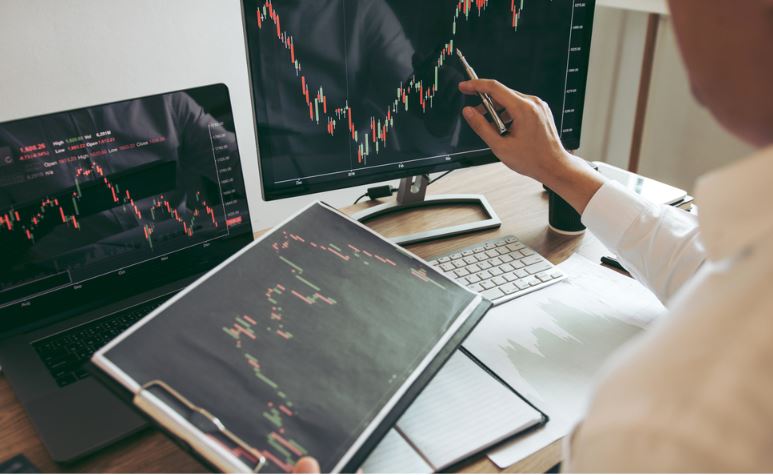Forex trading is a huge learning curve. You will make a ton of mistakes along the way and you will learn from these mistakes to become better traders as well. Here are the top mistakes made by forex traders today and how you can avoid them:
No Forex Knowledge
Avoid making the most common error in forex trading, which is to fool yourself into thinking you can be successful without any prior trading experience or expertise. You’d be surprised to learn how many beginner traders believe they are in some way extraordinary. They believe that they will be able to start earning money immediately. These dreams often have a brief lifespan and come at a high cost. Trading is a talent, and just like any other skill in the world, it needs some practice and experience before one can become excellent at it. And just like any other ability, you may either acquire it the hard way via practice and experience, or you can speed up the process by gaining knowledge from a more knowledgeable person.
In actual use, you will require both. The difficulty with trading for beginners is that they frequently misinterpret their luck with their level of experience. Nobody, regardless of their degree of expertise, has a better than even chance of making their first transaction a profitable one. You’d never get this with a talent like chess, art, or football activities in which fifty percent of novices quickly develop the false belief that they are capable of performing at an expert level. If you wish to surpass the majority of other Forex newbies, it is absolutely necessary for you to make an investment in a trading school that can actually assist you in comprehending how the markets and trading operations. You shouldn’t try to run before you can even walk. First master the fundamentals, and then proceed cautiously and gradually. Putting in the effort and resources to educate yourself about Forex trading is an investment in you as a person.
Risk Management
The most important aspect of your plan for managing risk is to determine how much of your available funds you are willing to put at risk on any individual deal. Day traders should, in an ideal scenario, risk no more than one percent of their total money on every single trade. This translates into the fact that a stop-loss order will terminate a transaction if it results in a loss of trading capital that is no greater than 1 percent. This indicates that even if you sustain losses in a succession of trades, just a tiny proportion of your total wealth will be wiped out. At the same time, if you generate a profit that is greater than one percent on each transaction that is successful, your losses will be made up for.
The regulation of day-to-day losses is an additional component of risk management. Even if you just put 1 percent of your cash at risk on each transaction, you still run the danger of losing a large portion of it on a single poor day. You need to determine the maximum daily loss that you are willing to accept as a percentage of the total sum. If you are able to withstand a daily loss of 3 percent, you need to have the self-control to quit when you reach that threshold. If you give it the chance, day trading may turn into an addiction. You should only wager the money that you have put aside for playing and you should stick to your plan at all times.
Too Much Leverage
One of the primary benefits of investing in financial markets such as forex trading is the potential to make use of leverage. With the use of leverage, you may trade a significantly larger position even if you just have a limited quantity of trading cash. However, leverage may have both positive and negative effects. It has the potential to increase both profitable and unprofitable transactions. One of the worst behaviors that traders may engage in is using a significant amount of leverage. Some people are only able to recognize the possible benefits and completely disregard any potential drawbacks.
If you utilize a high degree of leverage and the deal goes against you, you run the risk of losing all of your trading money as a result. Therefore, the most effective approach to applying leverage is to begin with a little investment. It is recommended that you choose the lowest degree of leverage that is made available by your trading provider. After you have gained a better understanding of how leverage operates, you will be able to raise the degree of leverage if you so want. It is important to keep in mind that just because there is a greater variety of leverage levels available to you does not imply that you are required to employ the maximum level that is available.
Revenge Trading
Even if you have a risk management plan in place, there will be occasions when you will be tempted to ignore it. This is something that will happen regardless. You’ll want to make a considerably greater deal than usual. The reasons are many, and by doing so, you will be encouraging fate to act in an unfavorable manner. You could have had a string of losing deals, which will motivate you to seek out opportunities to make up for some of the money you’ve lost. A run of wins might give the impression that you just cannot experience defeat.
There is always going to be one investment opportunity that promises such high profits that you are ready to put practically everything on the line for it. It is a mistake to take excessive risks, and mistakes have a tendency to snowball into much bigger problems. Traders have been known to use their stop-loss order in the event that they are optimistic about the market’s future. A lot of people also fall into the trap of maintaining their margin, convincing themselves that things will turn around and they’ll win big in the end. When you are experiencing this feeling, you should continue to adhere to your rules of 1 percent risk every transaction and 3 percent risk per day. Fight against temptation, stay true to your risk management approach, and don’t give in to the need to go all-in or add to your position.
Predicting The News
Following the publication of well-anticipated economic news, many currency pairings experience significant price movement in either direction. It would appear that forecasting the movement of a currency pair and entering a trade-in in that direction before any news is released, would be a simple and effective approach to generate a big profit. However, that is not the case.
Before settling into a regular movement in one way or the other, the price will frequently fluctuate fast and violently in both directions. This indicates that you have an equal chance of being involved in a large deal that goes against you within seconds of the news announcement as you have of being involved in a trade that goes in your favor. You should have a method that will bring you into a trade after the news has been released rather than trying to predict which way the market will move in response to the publication of the news.
Emotional Trading
It’s great to be passionate about trading, but you should never let your feelings control your trading behavior or force you into positions that you wouldn’t have otherwise taken. Make an effort to avoid making emotional trading errors. Take a brief minute to gather your thoughts and attempt to maintain your neutrality before entering into a transaction. Create a plan that will assist you in safeguarding yourself against making an excessive amount of emotional investment.
Too Many Positions
Even if there are a lot of different markets to trade in and a lot of different possibilities to trade every day, it is possible that taking on too many positions can hurt your trading. Monitoring an excessive number of positions can be difficult and loaded with risk. Keep in mind that the human brain is only capable of processing a certain amount of information at one time.
Because of the concentration that is required for each transaction, you only have a limited amount of time and attention to devote to each deal. When you have too many transactions open at once, there is a greater probability that some of them will be unsuccessful. Therefore, the next time you engage in trading, give careful consideration to the number of deals you execute. It is recommended to initially concentrate on a few deals and then restart the process if further possibilities for trading present themselves.
No Trading Plan
Your trading strategy should detail the principles you will follow for risk management, as well as how you will precisely enter and exit deals, regardless of whether those trades are profitable or not. If you do not have a trading plan, you are placing unnecessary bets on your investments. Before using your own money, you should first develop a trading strategy and check to see if it is profitable using a practice account.
Those who engage in day trading run the risk of both making and losing a fortune, therefore it is important to be aware of the potential red flags. To successfully plan and carry out any project requires patience, talent, and self-discipline. As you become more experienced in day trading, it is important to take a step back and modify your strategy as time goes on. You will discover that it is to your advantage to use various tactics at various times, particularly as your personal and financial circumstances continue to evolve.
Guessing Game
Traders that engage in a transaction without first doing the necessary preparatory steps should not be considered true traders. In point of fact, trading without making any effort towards knowledge or knowing how the markets function is more comparable to tossing some money into a game and praying for the best outcome.
Despite the fact that trading inherently involves some degree of unpredictability and volatility, traders may have a better sense of the kinds of deals that are most suited to them by spending time studying about and monitoring how the market operates.
Investing Too Big
As was discussed just a bit earlier, every trader is vulnerable to making errors, and it is expected that these errors will result in financial loss. Do not put too much of your capital at risk on your first few deals because new traders often commit more trading errors than those with greater levels of trading expertise. You should begin with minimal investment and gradually increase the size of your investments. In reality of course, prior to putting any money on the line, you should put your trading technique through its tests on a risk-free trading account in order to sharpen it to the greatest extent necessary before moving on to the real markets.




